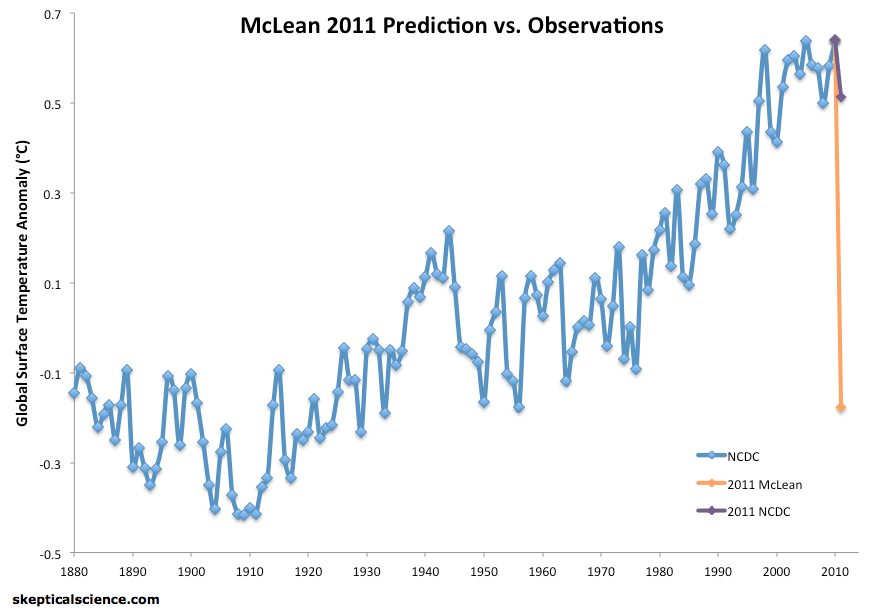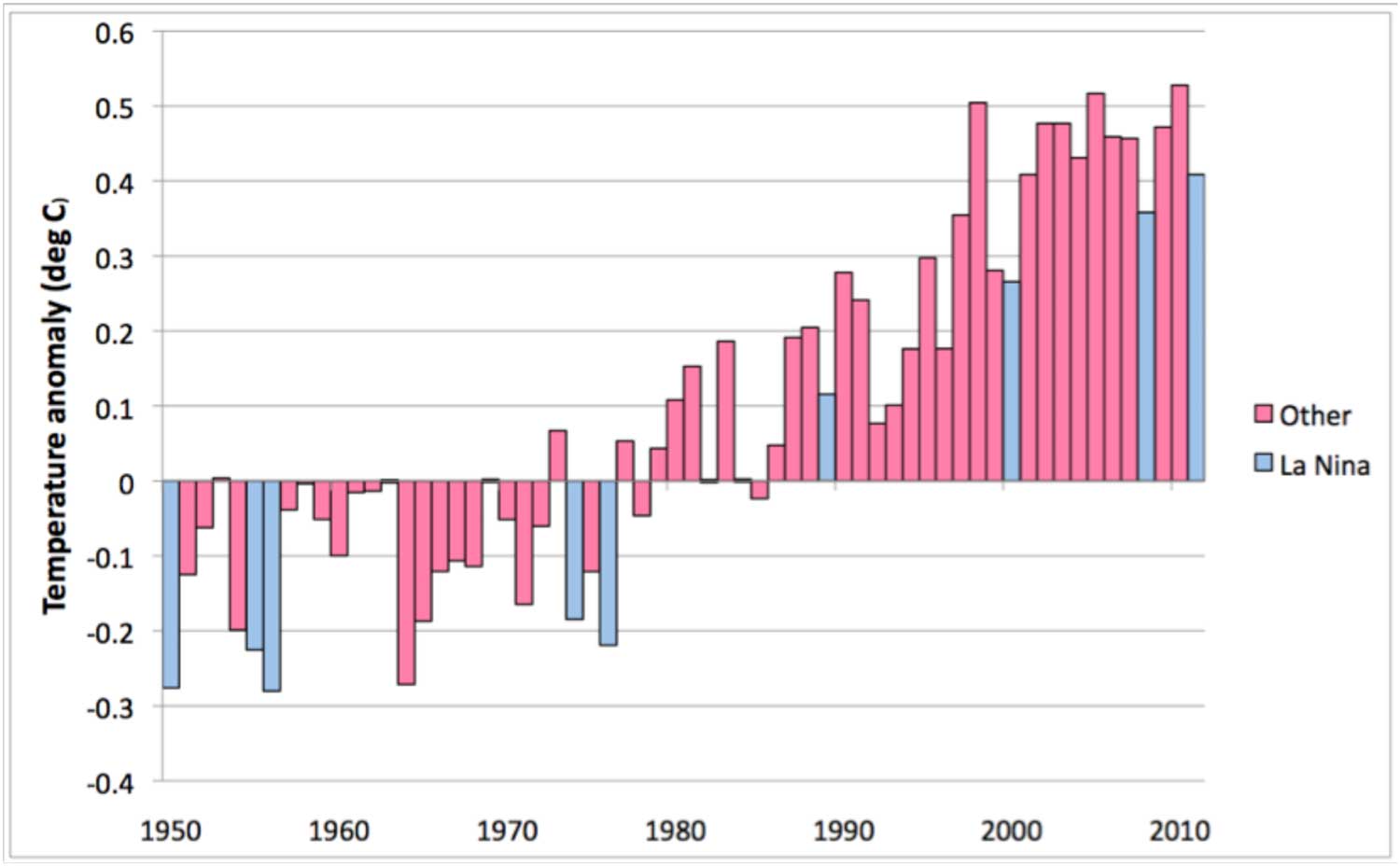The Year After McLean - A Review of 2011 Global Temperatures
Posted on 11 February 2012 by dana1981
 In The Day After McLean we examined a prediction by data analyst and member of the Australian Climate Science Coalition John McLean regarding the 2011 global average surface temperature:
In The Day After McLean we examined a prediction by data analyst and member of the Australian Climate Science Coalition John McLean regarding the 2011 global average surface temperature:
"it is likely that 2011 will be the coolest year since 1956 or even earlier"
The title of the post was a reference to the film The Day After Tomorrow (which depicts extremely rapid global cooling) because of the rapid cooling which would have to occur for McLean's prediction to come to fruition, as illustrated in Figure 1.
Figure 1: NCDC global average surface temperature from 1880 through 2010 (blue), McLean's 2011 prediction (orange), and the actual 2011 NCDC temperature (purple).
Even without knowing the actual 2011 temperature, the sheer magnitude of the temperature drop predicted by McLean, unrivaled in modern history, makes one wonder: what was he thinking?
La Niña
The basis of McLean's prediction was a paper we have previously examined, McLean et. al (2009). In their paper, McLean et al. found that the El Niño Southern Oscillation (ENSO) has a large influence on global temperature variability (i.e. short-term changes), but they also slipped a conclusion into their paper which was not supported by their research:
"Overall the results suggest that the Southern Oscillation exercises a consistently dominant influence on mean global temperature"
This claim is simply incorrect, and could not be supported by their research, because the first step in the McLean et al. analysis removed any long-term trends from the original temperature data. Thus their analysis was incapable of determining the dominant influences on long-term temperature changes.
However, 2011 was indeed influenced by a strong La Niña event. According to Foster and Rahmstorf (2011), there is a 2 to 4 month lag before changes in the Multivariate ENSO Index (MEI) are reflected in global surface temperatures. According to the MEI data, when applying a 3-month lag, 2011 was impacted by the 5th-largest La Niña influence of any given year since 1950, and the largest since 1974.
Thus McLean was correct to predict that La Niña would have a significant cooling effect, but he overestimated the strength of that cooling effect by an order of magnitude.
Short-Term Natural Temperature Influences
Using the results of the Foster and Rahmstorf (2011) multiple linear regression approach, ENSO had a cooling effect of approximately 0.08°C on the 2011 global surface temperature. However, the difference between the 2010 and 1956 temperatures (McLean's 2011 cooling prediction) was 0.8°C - McLean predicted that La Niña would have a cooling effect approximately 10 times larger than it actually did. Moreover, ENSO has not caused more than a 0.2°C year-to-year temperature swing since 1950, and the largest single year-to-year temperature swing in the NCDC record is 0.26°C (1963 to 1964, which was influenced by the Mt. Agung volcanic eruption).
Tamino has provided an update to Foster and Rahmstorf to include the 2011 data. When the effects of ENSO and solar and volcanic activity are removed from the temperature data, 2011 is either the 2nd- or 5th-hottest year on record, depending on which data set we choose (Figure 2).
Figure 2: Annual averages of the adjusted data from Foster and Rahmstorf (2011) with the effects of ENSO and solar and volcanic activity removed.
Refusing to Admit Mistakes
McLean has followed the example of fellow fake skeptic Patrick Michaels, who we recently saw has been unwilling to admit his obvious and indisputable errors in distorting the research of James Hansen and colleagues. In this case, there is no question that McLean's prediction was an exceptionally poor one. Any reasonably intelligent person would come to the same conclusion simply through a cursory examination of Figure 1 above.
And yet in 9 Months After McLean, we saw that McLean continued to stand behind his initial prediction halfway through 2011:
"Last time I looked 2011 wasn't over yet. It's a bit premature of you to be crowing about an annual average when the year isn't complete."
I have recently been in contact with McLean, who has promised to write a post about his prediction and results, which he claimed might somehow surprise me, but as of yet he has not produced the promised blog post.
Although Foster et. al (2010) showed that McLean et al. (2009) could not draw any conclusions about long-term temperature changes or influences, and although the invalid conclusion of the paper has clearly caused McLean to make a very wrong temperature prediction, he still refuses to admit his errors.
2011 - Another Hot Year
Regardless, 2011 predictably turned out to be another hot year. Taking the average of the NOAA NCDC, NASA GISS, and HadCRUT3 surface temperature records, 2011 was the 10th-hottest year on record. When the effects of ENSO and solar and volcanic activity are removed, Foster and Rahmstorf find it to be in the top 5 hottest years on record. Moreover, as the World Meteorological Association found, 2011 was the hottest La Niña year on record despite having the 5th-strongest La Niña influence since 1950, and the strongest since 1974 (Figure 3). This is a clear indication that human-caused global warming continues its inexorable rise underneath the short-term effects of natural variability.
Figure 3: Average of NOAA, GISS, and HadCRUT3 annual global surface temperature anomalies. Blue bars indicate years influenced by La Niña events. 2011 is the warmest La Niña-influenced year on record (Source: WMO)































 Arguments
Arguments

































[DB] Please note that Ken Lambert is engaged in pointless trolling, for which his last comment (since deleted) makes clear.
[Dikran Marsupial] Thanks DB, I have moderated my post in response to make sure it is still fair to Ken following the deletion of his post.[DB] Inflammatory snipped.